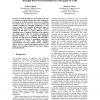39 search results - page 5 / 8 » Evolving Multi-agent Networks in Structured Environments |
CIG
2005
IEEE
13 years 11 months ago
2005
IEEE
Several attempts have been made in the past to construct encoding schemes that allow modularity to emerge in evolving systems, but success is limited. We believe that in order to c...
SIGMOD
2000
ACM
13 years 10 months ago
2000
ACM
We consider spatio-temporal databases supporting spatial objects with continuously changing position and extent, termed moving objects databases. We formally define a data model f...
TWC
2008
13 years 5 months ago
2008
We consider a multi-channel opportunistic communication system where the states of these channels evolve as independent and statistically identical Markov chains (the Gilbert-Elli...
CCS
2009
ACM
14 years 17 days ago
2009
ACM
Large-scale distributed systems have dense, complex code-bases that are assumed to perform multiple and inter-dependent tasks while user interaction is present. The way users inte...
GECCO
1999
Springer
13 years 10 months ago
1999
Springer
This paper discusses the simulation results of a model of biological development for neural networks based on a regulatory genome. The model’s results are analyzed using the fra...


